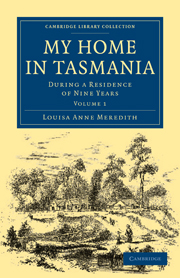Summary
The house at “Cambria” commands an extensive view of large tracts both of “bush” and cultivated land; and, across the Head of Oyster Bay, of the Schoutens, whose lofty picturesque outline, and the changing hues they assume in different periods of the day or states of the atmosphere, are noble adjuncts to the landscape. Below a deep precipitous bank on the south side of the house flows a winding creek, the outlet of the Meredith River, gleaming and shining along its stony bed, and richly fringed by native flowering shrubs, mingled with garden flowers half-wild, poppies, stocks, wallflowers, and bright-eyed marigolds looking merrily up, amidst thickets of the golden wattle and snowy tea-tree; whilst, on the higher ground, huge old gum-trees stand majestically, spreading wide their white fantastic branches, and shiny yet sombre foliage. At a short distance from the opposite bank of the creek stands a thatched cottage, with its attendant outhouses, partly concealed and shadowed by some particularly fine gum-trees, such as would be deemed highly ornamental even in an English park, for trees of this kind growing singly or in groups on rich land are scarcely recognisable as of the same genus with the gaunt scraggy objects that swarm together in the forests. The sight of this little cottage removes, rather pleasantly, the feeling of loneliness and isolation that generally pervades colonial country-houses, which are most commonly built each in or near the centre of its own estate; but in this instance the river, separating a large farm from a little one, has attracted the owners of both to place their houses near it.
- Type
- Chapter
- Information
- My Home in TasmaniaDuring a Residence of Nine Years, pp. 87 - 106Publisher: Cambridge University PressPrint publication year: 2010First published in: 1852

